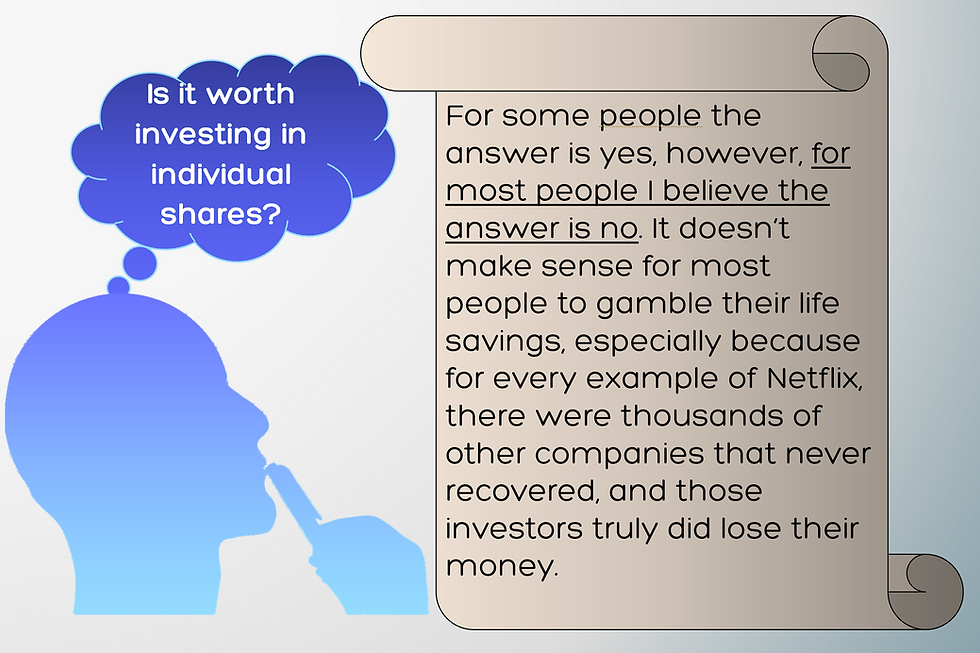The Importance(s) of Risk
- Cam Irvine

- Sep 26, 2022
- 3 min read
Updated: Oct 4, 2022
Everyone loves to boast about portfolio returns, but it makes sense that to get higher returns, a person will need to take on more risk. Many investors (and some advisers) will overlook the level of risk involved when picking investments or making money decisions. This is a problem for some obvious reasons and then some less obvious reasons.
Obvious Reasons
The more risk you take the more you expect your return to be over the long-term. It's ALWAYS important to remember the phrase "long-term" though. Many people will take on some aggressive risks by putting their money into Investment X, a property, a crypto, or something like that, then 6 months later, the investment has lost value, so they sold. This is a short-term investment time horizon, which is why you can get such different results over short and long periods of time (that's another topic). Taking on more risk can (that doesn't mean it will) work out well if someone has enough patience to wait. If they don't have patience, that's when dicey investment decisions are made.
Less Obvious Reason
People respond to stimuli. Things around us and inside our bodies cause reactions, so we adjust our behaviour. When something appears to be very risky or even worse, appears to not be risky and is, it’s a shock. This shock causes nervousness and when people are nervous, they make decisions differently than when they feel at ease. When it comes to watching an investment portfolio drop in value more than expected, it causes people to often change what they were doing with that money or worse, withdraw it – which means they lock in their losses. This is the real risk. Portfolios go up and down over time, which is fine, but if we react to those changes, then it can cause more harm than the temporary swings. Short answer = risk in portfolios affects people’s decisions. We call this, the behaviour gap.
Both reasons above are part of why risk matters so much, but they can get overlooked, especially for the investor that is impatient, competitive, or wants “the best” investment in the short-term.
Because you would expect an investment with higher risk to provide a higher return than one with low risk, it’s not really a fair comparison. This is why investments should always be viewed through a lens of risk-adjusted returns. There are several ways of measuring risk-adjusted returns, but we won’t explain them all here. Instead, it’s useful to know that some investments can offer incredibly high returns, but have very low risk-adjusted returns, because the investments are taking on more risk than an investor is being compensated for.
Here's an example:
If you invested $10,000 in Netflix, at its IPO on 29th of May 2002, and held onto it for 20 years to the 27th of May 2022, you’d have $1,768,666. Sound good? Well, had you sold it on the 15th of November 2022 you’d have had $6,160,039. Basically, you'd have about $4.5
million more. However, you would also have seen your investment drop in value by more than 70% on two different occasions and five more times you would have seen it cut in half.

That’s a lot of risk for the high return. Even the investors that did buy Netflix, they didn’t know how it was going to turn out, so many of them sold their positions during or after the drops. Do you know anyone that regrets selling their shares because the company they invested in has grown heaps since then?
“But wait, there’s more”
Finance follows some similar rules to physics. Think, “what goes up, must come down” - that applies to objects affected by gravity, but also investments. If you see an investment that has grown much more than any other in the same category, then always remember that it can (and odds are, it will) come back down at some point. This is part of the reason it's not a good idea to pick investments based on previous performance. The evidence shows it is not a good predictor. You can read more on the classic disclaimer of, “Past Performance is No Guarantee of Future Results”
Here's the point
A risk-adjusted return, such as a Sharpe Ratio, measures if an investments return makes sense for its amount of risk. This should be one consideration (of many) when picking an investment. One of the frustrations is that most investment literature in NZ, does not provide a Sharpe Ratio, and even when they do, it’s often before all the fees are deducted (which is not very honest, is it?).
Not only should you as an investor know of this concept, but you can always ask an adviser to explain it to you. If they do a good job, great. If they don’t, they probably shouldn’t be advising people how to invest their money.



Comments